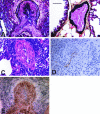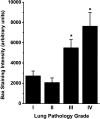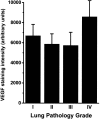S100A4/Mts1 produces murine pulmonary artery changes resembling plexogenic arteriopathy and is increased in human plexogenic arteriopathy
- PMID: 14695338
- PMCID: PMC1602221
- DOI: 10.1016/S0002-9440(10)63115-X
S100A4/Mts1 produces murine pulmonary artery changes resembling plexogenic arteriopathy and is increased in human plexogenic arteriopathy
Abstract
S100A4/Mts1 confers a metastatic phenotype in tumor cells and may also be related to resistance to apoptosis and angiogenesis. Approximately 5% of transgenic mice overexpressing S100A4/Mts1 develop pulmonary arterial changes resembling human plexogenic arteriopathy with intimal hyperplasia leading to occlusion of the arterial lumen. To assess the pathophysiological significance of this observation, immunohistochemistry was applied to quantitatively analyze S100A4/Mts1 expression in pulmonary arteries in surgical lung biopsies from children with pulmonary hypertension secondary to congenital heart disease. S100A4/Mts1 was not detected in pulmonary arteries with low-grade hypertensive lesions but was expressed in smooth muscle cells of lesions showing neointimal formation and with increased intensity in vessels with an occlusive neointima and plexiform lesions. Putative downstream targets of S100A4/Mts1 include Bax, which is pro-apoptotic, and the pro-angiogenic vascular endothelial growth factor (VEGF). The increase in S100A4/Mts1 expression precedes heightened expression of Bax in progressively severe neointimal lesions but in non-S100A4/Mts1-expressing cells. VEGF immunoreactivity did not correlate with severity of disease. The relationship of increased S100A4/Mts1 to pathologically similar lesions in the transgenic mice and patients occurs despite differences in localization (endothelial versus smooth muscle cells).
Figures







References
-
- Rabinovitch M. Diseases of the pulmonary vasculature. Topol EJ, editor. Philadelphia: Lippincott-Raven,; Comprehensive Cardiovascular Medicine. 1998:pp 3001–3029.
-
- Rabinovitch M, Haworth SG, Castaneda AR, Nadas AS, Reid LM. Lung biopsy in congenital heart disease: a morphometric approach to pulmonary vascular disease. Circulation. 1978;58:1107–1122. - PubMed
-
- Heath D, Edwards JE. The pathology of hypertensive pulmonary vascular disease. Circulation. 1958;18:533–547. - PubMed
-
- Rabinovitch M. Pathobiology of pulmonary hypertension: extracellular matrix. Clin Chest Med. 2001;22:433–449. - PubMed
Publication types
MeSH terms
Substances
LinkOut - more resources
Full Text Sources
Other Literature Sources
Molecular Biology Databases
Research Materials
Miscellaneous

